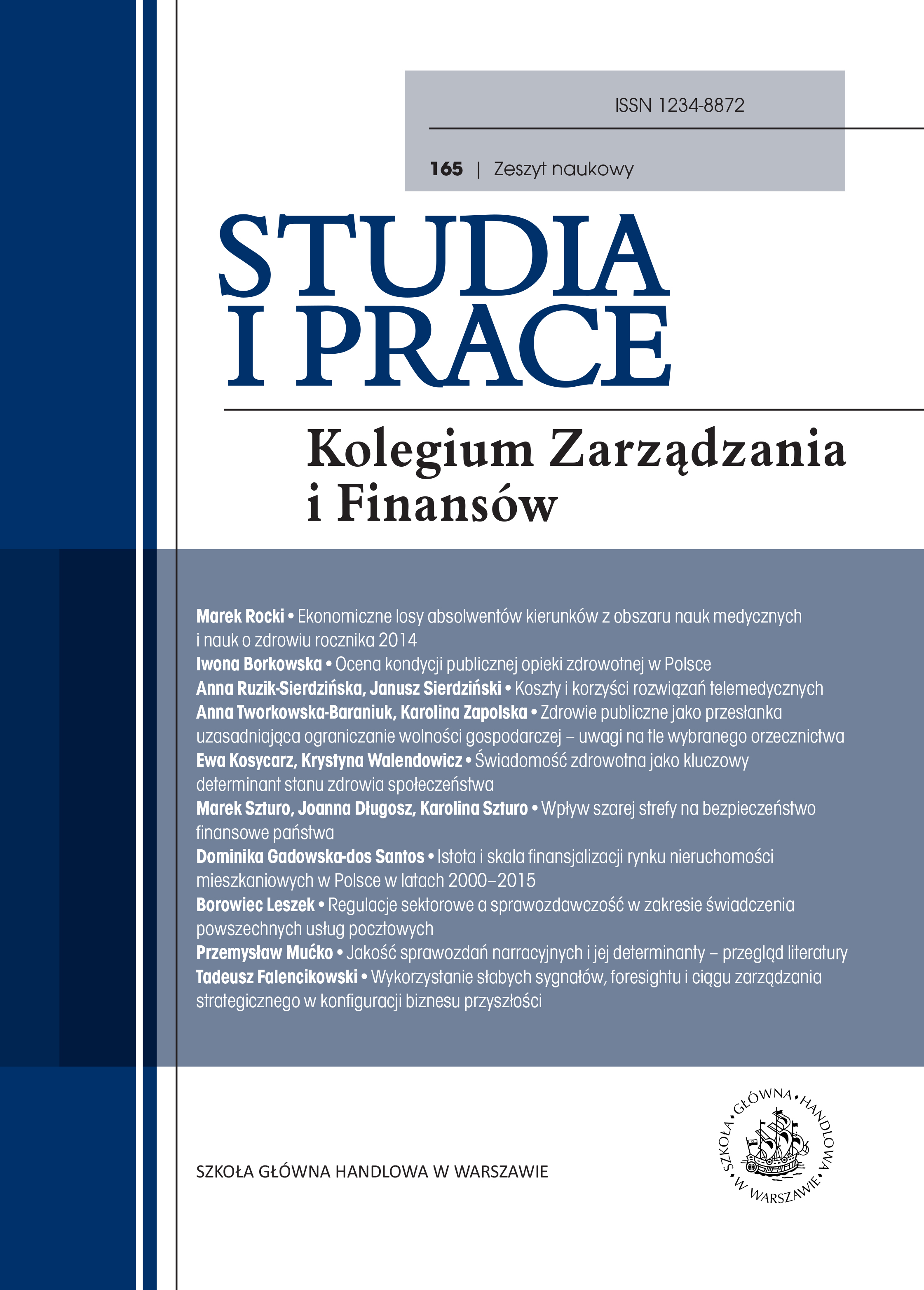koszty technologii
DOI:
https://doi.org/10.33119/SIP.2018.165.3Keywords:
telemedicine, cost-benefit analysis, cost of technologyAbstract
The paper aims at discussing economic costs and benefits of telemedicine based on the overview of the so far conducted studies.
In developed economies telemedical services represent a substantial portion of health care services and in some cases may even replace traditional diagnosing and treatment. Nowadays, technology is no more a barrier, limitations that are still faced include regulatory framework (or its absence) and financing. Especially with increasing costs generated by health care systems (due to technological progress in medicine, demographic changes and other social and economic factors) it is vital to compare costs and benefits of telemedical services. For reasons stated below, there are very few methodologically correct studies that would investigate into economic efficiency of adopted solutions:
- absence of an approved uniform methodology for making comparisons,
- focus on costs rather than on broadly interpreted economic benefits,
- limited possibilities to generalise the results caused by high heterogeneity of telemedical solutions,
- small samples of patients and no long-term data.
Summing up, costs and benefits of telemedical solutions are a little researched area, however, the existing evidence suggests that telemedicine can be effective at medical level and economically efficient.
Downloads
References
2. Bongiovanni-Delarozière I., Le Goff-Pronost M., Economic Evaluation Methods Applied to Telemedicine: From a Literature Review to a Standardized Framework, „European Research in Telemedicine” 2017, 6.
3. Bujnowska-Fedak M. M., Kumięga P., Sapilak B. J., Zastosowanie nowoczesnych systemów telemedycznych w opiece nad ludźmi starszymi, „Family Medicine & Primary Care Review” 2013, 15, 3.
4. Davalos M. E., French M. T., Burdick A. E., Simmons S. C., Economic Evaluation of Telemedicine: Review of the Literature and Research Guidelines for Benefit–Cost Analysis, „Telemedicine
and e-Health” 2009, 15 (10).
5. EC, eHealth Action Plan 2012–2020 – Innovative Healthcare for the 21st Century, COM(2012) 736 final.
6. European Union, The 2015 Ageing Report. Economic and Budgetary Projections for the 28 EU Member States (2013–2060), 2015.
7. Frączkowski K., Informatics Systems and Services in Healthcare Based on SOA Technology, „Acta Bio-Optica et Informatica Medica” 2010, 1.
8. Free C., Knight R., Robertson S., Whittaker R., Edwards P., Zhou W. i in., Smoking Cessation Support Delivered Via Mobile Phone Text Messaging (txt2stop): A Single-blind, Randomised
Trial, „Lancet” 2011, 378.
9. http://ec.europa.eu/economy_finance/publications/european_economy/2015/pdf/ee3_en.pdf
10. Koch S., Home Telehealth-current State and Future Trends, „International Journal of Medical Informatics” 2006, 75.
11. Kruse C. S., Mileski M., Moreno J., Mobile Health Solutions for the Aging Population: A Systematic Narrative Analysis, „Journal of Telemedicine and Telecare” 2017, 23 (4).
12. Martyniak J., Podstawy informatyki z elementami telemedycyny, Wydawnictwo UJ, Kraków 2009.
13. Mistry H., Systematic Review of Studies of the Cost-effectiveness of Telemedicine and Telecare. Changes in the Economic Evidence Over Twenty Years, „Journal of Telemedicine and Telecare” 2012, 18, 1.
14. Mitchell J., From Telehealth to E-health: The Unstoppable Rise of E-health, National Office for the Information Technology, Australia, Canberra 1999.
15. Moehr J. R., Schaafsma J., Anglin C., Pantazi S. V., Grimm N. A., Anglin S., Success Factors for Telehealth a Case Study, „International Journal of Medical Informatics” 2006, 75, 10–11.
16. Morris S., Devlin N., Parkin D., Economic Analysis in Health Care, John Wiley & Sons, 2007.
17. NFZ, Prognoza kosztów świadczeń opieki zdrowotnej finansowanych przez Narodowy Fundusz Zdrowia w kontekście zmian demograficznych w Polsce, Warszawa 2015, listopad.
18. Silva B., Rodrigues J., de la Torre Díez I., López-Coronado M., Saleem K., Mobile-health: A Review of Current State in 2015, „Journal of Biomedical Informatics” 2015, 56.
19. Stroetmann K. A., Jones T., Dobrev A., Stroetmann V. N., eHealth is Worth it. The Economic Benefits of Implemented eHealth Solutions at Ten European Sites, European Commission,
Luxembourg 2006.
20. Tadeusiewicz R., Telemedycyna – nowe wyzwanie współczesnej nauki, „Nauka” 2004, 3.
21. Whitten P. S., Mair F. S., Haycox A., May C. R., Williams T. L., Hellmich S., Systematic Review of Cost Effectiveness Studies of Telemedicine Interventions, „BMJ: British Medical Journal”
2002, 324 (7351).
22. WHO, A Health Telematics Policy in Support of WHO’s Health-For-All Strategy for Global Health Development: Report of the WHO Group Consultation on Health Telematics,
11–16 December, Geneva 1997, Geneva 1998.
23. WHO, mHealth. New Horizons for Health through Mobile Technologies, „Global Observatory for eHealth series” 2011, vol. 3, http://www.who.int/goe/publications/goe_mhealth_web.pdf
24. Zgliczyński W., Pinkas J., Cianciara D., Sitarek M., Berdyga T., Nowicka-Wasilewska J., Kawwa J., Telemedycyna w Polsce – bariery rozwoju w opinii lekarzy, „Postępy Nauk Medycznych”
2013, 19.
25. Zurovac D., Sudoi R., Akhwale W. S., Ndiritu M., Hamer D., Rowe A. K., The Effect of Mobile Phone Text-message Reminders on Kenyan Health Workers’ Adherence to Malaria Treatment
Guidelines: A Cluster Randomised Trial, „Lancet” 2011, 378.









